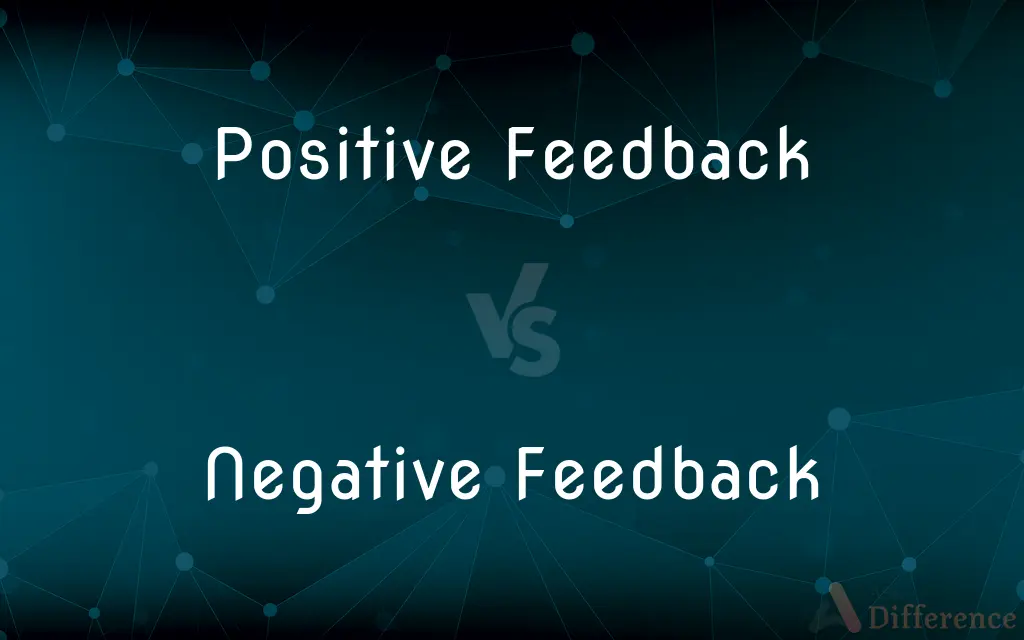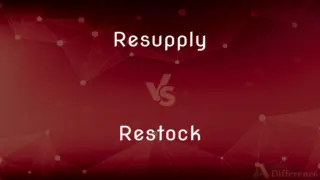Positive Feedback vs. Negative Feedback — What's the Difference?
By Tayyaba Rehman — Published on November 20, 2023
Positive Feedback amplifies or reinforces a process or behavior, while Negative Feedback diminishes or corrects it to maintain stability or equilibrium.

Difference Between Positive Feedback and Negative Feedback
Table of Contents
ADVERTISEMENT
Key Differences
Positive Feedback is a process or system in which the end product or result enhances or amplifies the initial change. It often leads to a further escalation or enhancement of the output or behavior. In many contexts, Positive Feedback serves to push systems or processes away from their initial states.
Negative Feedback, in contrast, operates to counteract or reduce a change or deviation, bringing the system or process back to its desired state or equilibrium. It's a self-regulating mechanism that helps maintain stability by making adjustments in response to external changes or disturbances.
In the context of communication, Positive Feedback often refers to praise or affirmative responses that encourage repetition of a behavior or action. It reinforces the behavior and motivates individuals to continue or even enhance that behavior.
On the other hand, Negative Feedback, when discussing communication, typically means constructive criticism or corrective responses. This type of feedback aims to highlight areas of improvement, guiding individuals to modify or adjust their actions or behavior.
In essence, while Positive Feedback tends to boost, enhance, or encourage processes or behaviors, Negative Feedback aims to stabilize, correct, or regulate them, ensuring a balance or desired outcome.
ADVERTISEMENT
Comparison Chart
Direction of Effect
Amplifies or enhances a process or behavior
Reduces or corrects a process or behavior
Outcome
Pushes away from a set point or equilibrium
Pulls towards a set point or equilibrium
Purpose in Systems
Escalation or enhancement
Stability or balance
In Communication
Praise or affirmative response
Constructive criticism or corrective response
Effect on Behavior
Encourages repetition or continuation
Guides modification or adjustment
Compare with Definitions
Positive Feedback
Constructive reinforcement that encourages repetition of an action.
The Positive Feedback from users led to more updates of the app.
Negative Feedback
A response that counteracts or corrects a deviation or change.
The Negative Feedback from the thermostat turned the heating off as the room warmed.
Positive Feedback
Affirmation or praise that motivates continuation or enhancement.
The team's success was attributed to the consistent Positive Feedback from their coach.
Negative Feedback
A self-regulating mechanism maintaining stability or equilibrium.
The body uses Negative Feedback to maintain core temperature.
Positive Feedback
A system's output that promotes further escalation of the same output.
The rising temperatures created a Positive Feedback loop, melting more ice.
Negative Feedback
A system's output that diminishes or opposes the initial change.
In ecosystems, predator-prey dynamics often involve Negative Feedback loops.
Positive Feedback
An escalating cycle where an initial change leads to a greater change.
The applause was Positive Feedback, leading the performer to add an encore.
Negative Feedback
Constructive criticism aiming to guide improvement or adjustment.
The editor's Negative Feedback helped the writer refine his article.
Positive Feedback
A response that reinforces or amplifies a process or behavior.
Receiving Positive Feedback on her presentation boosted her confidence.
Negative Feedback
Responses that signal the need for modification or redirection.
The customer's Negative Feedback prompted the restaurant to change its menu.
Common Curiosities
How does Negative Feedback differ from Positive Feedback?
Negative Feedback counteracts or corrects deviations, aiming to bring systems or behaviors back to a desired state.
How can Positive Feedback influence human behavior?
Positive Feedback, like praise or rewards, can motivate individuals to continue or enhance a behavior.
Can Positive Feedback cause instability?
Yes, unchecked Positive Feedback can disrupt balance and cause instability in systems.
Why might a company seek Negative Feedback?
Companies may seek Negative Feedback to identify areas of improvement and enhance products or services.
What is Positive Feedback?
Positive Feedback amplifies or reinforces a behavior or process, often leading to its escalation.
Why is Negative Feedback important in systems?
Negative Feedback helps maintain stability or equilibrium by making adjustments in response to changes.
Is Positive Feedback always good?
Not always. While it can be motivating, unchecked Positive Feedback can lead to overconfidence or system imbalances.
How does Positive Feedback affect ecosystems?
In ecosystems, Positive Feedback can lead to rapid changes, like algae blooms due to nutrient influx.
Can Positive Feedback create a loop?
Yes, Positive Feedback can create self-amplifying loops where the output promotes further escalation.
Can Negative Feedback be constructive?
Yes, Negative Feedback can be constructive when it provides guidance for improvement or adjustment.
How do Positive and Negative Feedback loops interact in systems?
They often work in tandem: Positive Feedback may drive change, while Negative Feedback counters to maintain stability.
When is Negative Feedback beneficial?
Negative Feedback can guide improvements, maintain balance in systems, and prevent undesirable outcomes.
How do homeostatic systems in the body utilize Negative Feedback?
The body uses Negative Feedback to regulate functions like temperature, blood sugar levels, and blood pressure.
Is Negative Feedback always negative in tone?
No, Negative Feedback can be delivered positively and constructively, focusing on areas of improvement.
Does Positive Feedback always lead to growth?
Not necessarily. While Positive Feedback can promote growth or escalation, other factors can limit or check it.
Share Your Discovery

Previous Comparison
Resupply vs. Restock
Next Comparison
MPEG vs. MP3Author Spotlight
Written by
Tayyaba RehmanTayyaba Rehman is a distinguished writer, currently serving as a primary contributor to askdifference.com. As a researcher in semantics and etymology, Tayyaba's passion for the complexity of languages and their distinctions has found a perfect home on the platform. Tayyaba delves into the intricacies of language, distinguishing between commonly confused words and phrases, thereby providing clarity for readers worldwide.












































